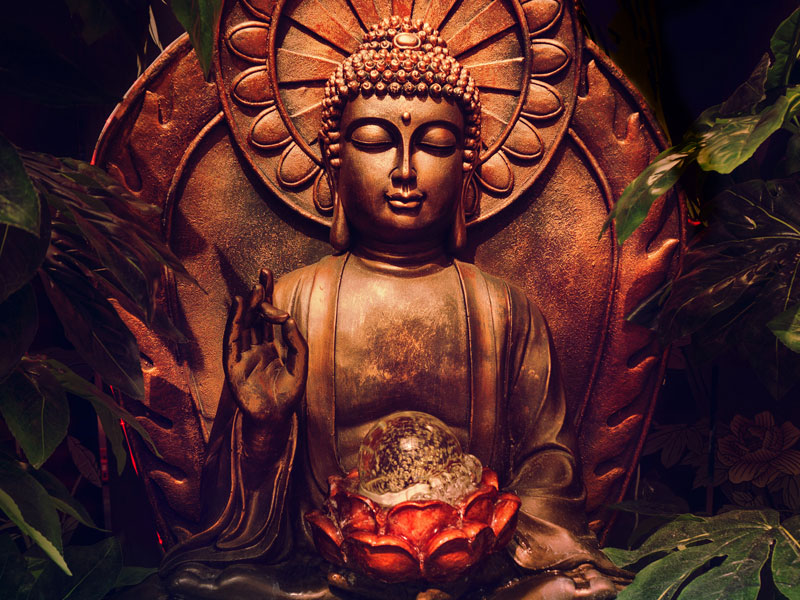
Buddha’s life
-born 563 BC at Lumbinivana,Nepal – Sakya Kshatriya Clan
-father- Suddhodhana-king of republic Kapilvastu
-mother-Mahamaya- princess of Kollia republic
-Step-mother and aunt- Mahaprajapati Gautami
-wife- Yashodhara-priness of Shakya dynasty-son Rahul
–4 sights-turning point-1.old man,2.diseased person,3.dead body and 4. Ascetic
-age 35-under a pipal tree at Uruvella(Bodh Gaya) on the bank of river Niranjana(Falgu)-he attained Nirvana(Enlightenment) after 49 days of meditation
-1st sermon -Sarnath deer parkto 5 disciples- Dharmachakra Pravartana(turning of the wheel of law)
-died at the age of 80 in 483 BC at Kushinagar(Village Kasia in Kushinagar in UP)
Great Events of Buddha’s Life and Symbols
1.Janma(birth)-Lotus and Bull
2.Mahabhinishkramana (Renunciation)-Horse
3.Nirvana(Enlightenment)-Bodhi Tree
4.Dharmachakra Pravartana(First Sermon)-Wheel
5.Mahaparinirvana(Death)- Stupa
Beliefs/Doctrines-
–Nirvana– salvation which means a tranquil state of mind in which all sorts of cravings become extinct- secure release from chain of birth and death
–Law of Karma– a man’s condition in the present life is determined by the consequences of his actions in his past existence
–Ahimsa
-No faith in caste system
-silent about existence of God ,without formally denying it,belief in universal law called Dharma
-no faith in Yajna,sacrifice,rituals
–Emphasis on Morality-Code of Social Conduct-
1.not to lie
2.not to steal or covet other’s property
3.non-violence
4.not to use intoxicants
5.not to indulge in corrupt practices
Chatwari Arya Satyani- Four Noble Truths
The Four Noble Truths, which Buddha taught, are:
1.The truth of suffering (dukha)
2.The truth of the cause of suffering (dukkha samudaya)
3.The truth of the end of suffering (dukkha nirhodha)
4.The truth of the path that frees us from suffering (Ashtangika Marga)
Ashtangika Marg or Eight Fold Path
1.Right Understanding
2.Right Action
3.Right Attitude
4.Right Livelihood or Vocation
5.Right Speech
6.Right Effort
7.Right Mindfulness
8.Right Concentration
An important guiding principle of Buddhist practice is the Middle Way,i.e. the practice of non-extremism: a path of moderation away from the extremes of self-indulgence and self-mortification.
Sects of Buddhism
1. Hinayana-the Lesser Vehicle
-belief in original teachings of Buddha
-salvation through self discipline and meditation
-no belief in idol worship
-Pali language
-Southern Buddhist Religion -prevailed in South of India,Sri Lanka,Myanmar,Thailand,Java etc
-2 subsects- Vaibhasika and Sautantrika
2.Mahayana- The Greater Vehicle
-Followers believed in heavenliness of Buddha
-Salvation through Buddha and Bodhisatva
-Belief in idol worship
-Sanskrit language
-Northern Buddhist Religion-China,Korea,Japan etc
2 subsects-Madhyamika/Shunyavada(founder- Nagarjuna) and Yogachari/Vijnanavada (founder- Maitreyanath and disciple Asanga)
3.Vajrayana
-salvation through magical power called Vajra
-chief divinities – Taras
-popular in eastern India-Bengal and Bihar
Triratna- Three Jewels of Buddhism
1.Buddha – the enlightened
2.Dharma- doctrine
3.Sangha- commune
4 buddhist Councils
- 483 BC– Saptaparni Cave, Rajgriha-chairman Mahakassapa– patron Ajatashatru
- 383 BC– Chullavanga Vaishali -chaired by Sabbakami-patronised by Kalashoka
- 250 BC– Ashokarama Vihar,Patliputra -chaired by Mogaliputta Tissa- patronised by Ashoka
- 98 AD– Kunadala Vana,Kashmir– chaired by Vasumitra,Vice chairman-Ashvaghosa-patronised by Kanishka
Buddhist Literature
1.Pali Texts
Tripitaka– Sutta Pitaka-Buddha’s sayings
Vinay Pitaka-Monastic Code
Abhidhamma Pitaka- religious discourses
Milindpanho– Dialogue between Milinda(Menander,Indo Greek ruler) and Nagasena
Dipavamsha and Mahavamsha– the great chronicles of Sri Lanka
2. Sanskrit Texts
Buddha Charita,Saundarananda,Sutralankar,Sariputra Prakaran and Vajra Suchi- Asvaghosa
Mahavibhasha Shastra- Vasumitra
Visudhamagga,Atthakathayen and Sumangalvasini- Buddhaghosha
Madhyamika Karika and Prajnaparimita Karika- Nagarjuna
Factors responsible for the spread of Buddhism
-magnetic personality of Buddha
-simplicity of religion
-no caste system
-missionary religion
-activity of the Sangha
-Buddhist Councils
-liberal spirit and adaptabilities
-royal patronage
-simple language
Causes of Downfall
-revival of Brahmanical religion
-corruption and split in Buddhist Sangha
-idol worship
-adoption of Sanskrit
-loss of royal patronage
-foreign invasions
Now, Take the test on this Topic – QUIZ : Buddhism and Jainism



